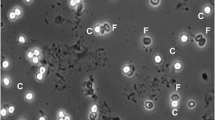Abstract
The detection ofCryptosporidium parvum oocysts in stool specimens by acid-fast (AF) stains or immunofluorescence assays (IFA) requires the presence of large numbers of oocysts. To determine whether new commercially available enzyme immunoassays (EIAs) are more sensitive alternatives, three EIAs, a direct IFA, and the modified cold Kinyoun AF stain were compared, particularly with respect to detection of low oocyst numbers or antigen concentrations. Thirty-one negative and 31 calf stool-enriched human stool specimens were tested. One EIA method detected only nine positive specimens, demonstrating a sensitivity significantly less (p<0.0001) than that of the IFA, the AF stain, and the other two EIAs. No differences could be found with respect to specificity. In addition, serial dilutions of 28 patients' stool samples containing cryptosporidian oocysts were prepared and examined using two EIAs, IFA, and the AF stain. One EIA yielded significantly inferior results (p<0.0001), whereas the other one and the two microscopic methods did not differ significantly in either part of the study. The results indicate that the new EIAs do not exhibit higher sensitivities for detection ofCryptosporidium parvum than the two routinely used microscopic methods. Thus, for most laboratories, the IFA or AF stain may still represent the preferred method for the diagnosis of cryptosporidiosis.
Similar content being viewed by others
References
Tyzzer EE: A sporozoan found in the peptic glands of the common mouse. Proceedings of the Society for Experimental Biology and Medicine 1907, 5: 12–13.
Meisel JL, Perera DR, Meligro C, Rubin CE: Overwhelming watery diarrhea associated withCryptosporidium in an immunosuppressed patient. Gastroenterology 1976, 70: 1156–1160.
Nime FA, Burek JD, Page DL, Holscher MA, Yardley JH: Acute enterocolitis in a human being infected with the protozoanCryptosporidium Gastroenterology 1976, 70: 592–598.
Current WL, Garcia LS: Cryptosporidiosis. Clinical Microbiology Reviews 1991, 4: 325–358.
Garcia LS, Bruckner DA, Brewer TC, Shimizu RY: Techniques for the recovery and identification ofCryptosporidium oocysts from stool specimens. Journal of Clinical Microbiology 1983, 18: 185–190.
MacPherson DW, McQueen R: Cryptosporidiosis: multiattribute evaluation of six diagnostic methods. Journal of Clinical Microbiology 1993, 31: 198–202.
Garcia LS, Brewer TC, Bruckner DA: Fluorescent detection ofCryptosporidium oocysts in human fecal specimens by using monoclonal antibodies. Journal of Clinical Microbiology 1987, 25: 119–121.
Sterling CR, Arrowood M: Detection ofCryptosporidium spp. infections using a direct immunofluorescent assay. Pediatric Infectious Disease Journal 1986, 5, Supplement 1: 139–142.
Weber R, Bryan RT, Bishop HS, Wahlquist SP, Sullivan JJ, Juranek DD: Threshold of detection ofCryptosporidium oocysts in human stool specimens: evidence for low sensitivity of current diagnostic methods. Journal of Clinical Microbiology 1991, 29: 1323–1327.
Kotler PD, Francisco A, Clayton F, Scholes JV, Orenstein JM: Small intestinal injury and parasitic diseases in AIDS. Annals of Internal Medicine 1990, 133: 444–449.
Rosenblatt JE, Sloan LM: Evaluation of an enzyme-linked immunosorbent assay for detection ofCryptosporidium spp. in stool specimens. Journal of Clinical Microbiology 1993, 31: 1468–1471.
Ungar BLP: Enzyme-linked immunoassay for detection ofCryptosporidium antigens in fecal specimens. Journal of Clinical Microbiology 1990, 28: 2491–2495.
Parisi MT, Tierno PM Jr: Evaluation of new rapid commercial enzyme immunoassay for detection ofCryptosporidium oocysts in untreated stool specimens. Journal of Clinical Microbiology 1995, 33: 1963–1965.
Scholten TH, Yang J: Evaluation of unpreserved and preserved stools for the detection and identification of intestinal parasites. American Journal of Clinical Pathology 1974, 62: 563–567.
Yang J, Scholten TH: A fixative for intestinal parasites permitting the use of concentration and permanent procedures. American Journal of Clinical Pathology 1977, 67: 300–304.
Arrowood MJ, Sterling CR: Comparison of conventional staining methods and monoclonal antibody-based methods forCryptosporidium oocyst detection. Journal of Clinical Microbiology 1989, 27: 1490–1495.
Kehl KSS, Cicirello H, Havens PL: Comparison of our different methods for detection ofCryptosporidium species. Journal of Clinical Microbiology 1995, 33: 416–418.
Balatbat AB, Jordan GW, Tang YJ, Silva J Jr: Detection ofCryptosporidium parvum DNA in human feces by nested PCR. Journal of Clinical Microbiology 1996, 34: 1769–1772.
Author information
Authors and Affiliations
Rights and permissions
About this article
Cite this article
Ignatius, R., Eisenblätter, M., Regnath, T. et al. Efficacy of different methods for detection of lowCryptosporidium parvum oocyst numbers or antigen concentrations in stool specimens. Eur. J. Clin. Microbiol. Infect. Dis. 16, 732–736 (1997). https://doi.org/10.1007/BF01709253
Issue Date:
DOI: https://doi.org/10.1007/BF01709253




